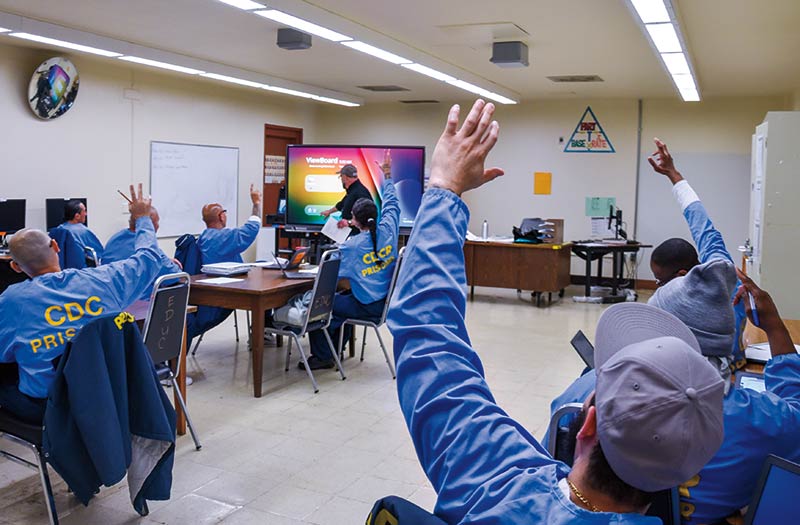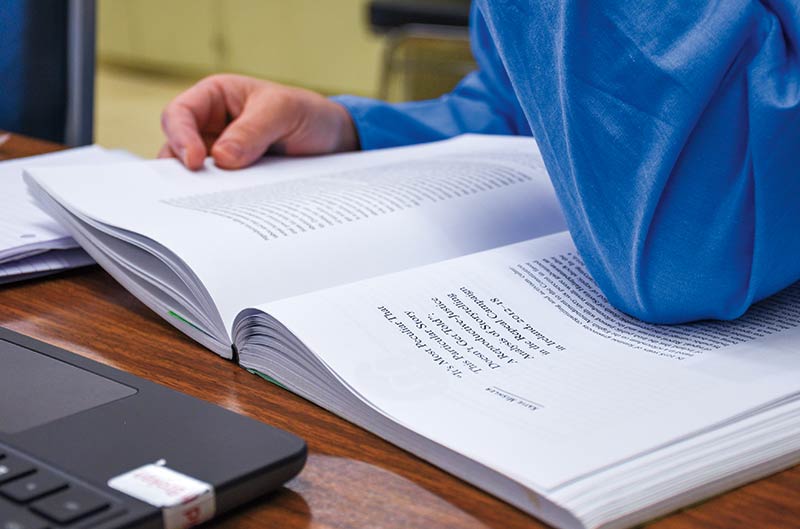Program Changes Lives at Pelican Bay State Prison
By Melissa Hutsell
Photos by Tiffany L. Conover, Pelican Bay State Prison
EACH WEEK, STUDENTS file into their classroom to learn about topics including culture, gender, social advocacy, and theories of communication—a familiar scene on college campuses. But what sets this classroom apart is that it’s in Pelican Bay State Prison, where the first program of its kind is increasing employment opportunities while also decreasing the chance inmates will return to prison once they serve their time.
For Antonio, who’s been incarcerated for two decades, the program is a lighthouse for inmates navigating stormy seas.
He is one of 16 students in Cal Poly Humboldt’s B.A. in Communication program at Pelican Bay State Prison. It’s the first B.A. program to be taught in person on a Level IV yard (high-security facility) in California.
Antonio, who’s serving 90-years-to-life at Pelican Bay, is pursuing the program to better himself and show his family that he is more than his past.
“Knowledge and self-education have helped me a great deal. It has allowed me to develop and grow in a place that lacks milestones ordinary human beings have in a free society,” he says. “Education has freed my mind even as my body remains incarcerated.”
The program is a partnership among Humboldt, College of the Redwoods, and the California Department of Corrections and Rehabilitation (CDCR). The first cohort started in January 2024 with 16 students who completed their associate’s degrees through College of the Redwoods’ Pelican Bay Scholars Program.
“CDCR is proud to partner with Cal Poly Humboldt to greatly expand degree-earning opportunities for incarcerated students and further the Department’s commitment in expanding ‘grade school to grad school’ opportunities,” said CDCR Secretary Jeff Macomber. “Collaborative efforts between CDCR and California’s public higher education system are truly transforming lives.”
“It saved mine,” says Darryl, who has spent several decades in the Security Housing Unit.
Darryl says the program is changing the narrative and setting an example for the future at Pelican Bay State Prison. It is giving students the opportunity to look at life through a different lens and a greater chance of success once released.
“You begin to mold and create a better version of yourself, an image that reflects your true being, something you can be proud of… a persona that begins to take on a new meaning with principles, someone with integrity that’s in conjunction with pro-social values,” he says.

Cal Poly Humboldt’s B.A. in Communication program at Pelican Bay State Prison is the first B.A. program to be taught in person in a Level IV yard (high-security facility) in California
Research shows that access to education significantly reduces recidivism rates. According to the nonprofit global policy think tank RAND Corporation, formerly incarcerated people are 43% less likely to re-offend and are more likely to be employed when they participate in any type of education program.
The economic impact is also measurable, adds RAND, which finds that every dollar invested in prison education programs saves nearly $5 in reincarceration costs over a period of three years. “Education is medicine for recidivism,” says Tony Wallin-Sato ('20, Journalism) director of the Cal Poly Humboldt chapter of Project Rebound, which helped to start the B.A. program. “It is one of the greatest rehabilitative programs we can offer.”
Project Rebound provides support for formerly incarcerated individuals at 15 California State University (CSU) campuses throughout the state. It stands as a testament to the transformative power of education with less than a 1% recidivism rate among its students who finish their degree.
“Ninety-five percent of incarcerated individuals are going to come home, and we should create the greatest possible reentry plan for them for success,” Wallin-Sato says. “A four-year degree from a public university in California costs approximately $32,000, and a single year in prison in California on average costs $100,000. If we deny formerly incarcerated people an education, we are throwing away money instead of working towards compassionate-centered work.”

These titles are a testament to a half-century of excellence for both programs.
“At Cal Poly Humboldt, we define ourselves by who we include and not who we exclude,” says Jenn Capps, provost and vice president for Academic Affairs at Cal Poly Humboldt. “Creating access to education is one of our primary goals, and launching the bachelor’s degree at Pelican Bay does just that.”
Cal Poly Humboldt joins several higher education institutions across the U.S. that are expanding access to education to incarcerated students, including Cal State San Bernardino.
Students enrolled in the B.A. program can now receive Pell Grants, starting in Fall 2024. The program is the first in the nation to be approved for eligibility by the U.S. Department of Education under a new federal policy that went into effect last July.
The Communication degree is particularly advantageous for Pelican Bay scholars. It prepares graduates for a wide range of career options and teaches skills that employers desire, such as effective communication and critical listening skills. The job market for this and similar fields is expected to grow over the next decade, according to the Bureau of Labor Statistics.
Communication is the only B.A. currently offered through the program, but project partners hope to expand options. The first cohort is expected to graduate in spring 2028 with a commencement ceremony in the prison.
Jaime, a Pelican Bay B.A. scholar who’s serving a 40-years-to-life sentence, hopes to use his degree to inspire and improve the conditions of people who have been systemically oppressed and marginalized, and who have been left to fend for themselves. Jaime says, “I want to create programs that provide awareness and different visions of success for Black and Brown kids who look up to gang members, drug dealers, and criminals as role models.”
“I want to be that person who these kids can relate to through my story of struggle and success. By introducing kids to people who look like them and come from the same environment they do, I hope to sow seeds of aspiration and self-determination. I want to be of service to those who do not believe in themselves because life has placed them within the lower rung of the social ladder—this is how I plan to apply my degree and knowledge I’ve gained through Cal Poly Humboldt.”